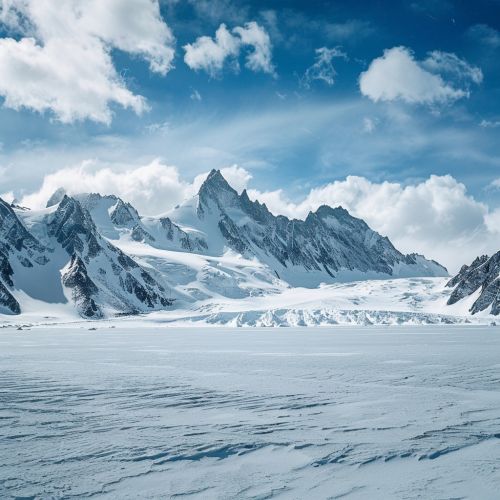Icefield
Overview
An icefield, also known as an ice cap, is a large area of interconnected glaciers, typically found in the colder regions of the world. They are smaller than ice sheets and form primarily in mountainous areas. Icefields are crucial components of the Earth's cryosphere, playing a significant role in global climate regulation and serving as vital freshwater reservoirs.
Formation and Characteristics
Icefields form through the accumulation of snow over many years, which compresses into firn and eventually transforms into ice. This process, known as nivation, is facilitated by cold temperatures and high precipitation levels. The icefield continues to grow as long as the accumulation of snow and ice exceeds the loss from melting and sublimation.
An icefield's surface is often characterized by a series of interconnected valley glaciers. Unlike ice sheets, which are dome-shaped and spread out from a central point, icefields are controlled by the topography of the land beneath them. They tend to form over high-altitude plateaus and fill the surrounding valleys with ice.


Distribution
Icefields are found in various parts of the world, predominantly in polar and high-altitude regions. The largest icefields are located in the non-polar regions of Canada and Alaska. Notable examples include the Columbia Icefield in the Canadian Rockies and the Juneau Icefield in Southeast Alaska. Smaller icefields are also found in the Andes, the Alps, the Himalayas, and several other mountain ranges.
Ecological Significance
Icefields have a profound impact on the ecosystems in which they exist. They influence local climate conditions, create unique habitats for flora and fauna, and contribute to the formation of distinctive landforms such as fjords, moraines, and cirques.
Moreover, icefields are vital freshwater resources. They store vast amounts of water in the form of ice, which gradually melts and feeds into rivers and lakes. This process is particularly important in regions where other sources of freshwater are scarce.
Climate Change and Icefields
Icefields, like other components of the cryosphere, are highly sensitive to changes in climate. Global warming has led to a significant reduction in the size of many icefields around the world. This loss of ice mass has far-reaching implications, including rising sea levels, altered water cycles, and impacts on wildlife and human communities that rely on icefields for water and other resources.
